Brandman University: Analysis of Domestic Violence Interview Report
VerifiedAdded on 2022/08/13
|15
|4312
|35
Report
AI Summary
This report presents an analysis of an interview with a retired psychologist, focusing on domestic violence against women. The interview explores various aspects of domestic violence, including approaches to clients, the consequences of abuse, and the different therapeutic interventions available. The report delves into the challenges of establishing trust with victims and the importance of confidentiality, while also examining the psychological effects such as anxiety, PTSD, and the potential for long-term health issues. It discusses the complexities of perpetrator behavior, including the role of remorse, substance abuse, and mental health conditions. The report also examines the cycle of abuse, the impact of childhood experiences, and the evolutionary psychological explanations for domestic violence. Finally, it touches upon the willingness of men to seek therapy and the role of power dynamics in relationships. The assignment highlights the critical role psychologists play in helping individuals navigate these difficult situations and provides valuable insights into the multifaceted nature of domestic violence.
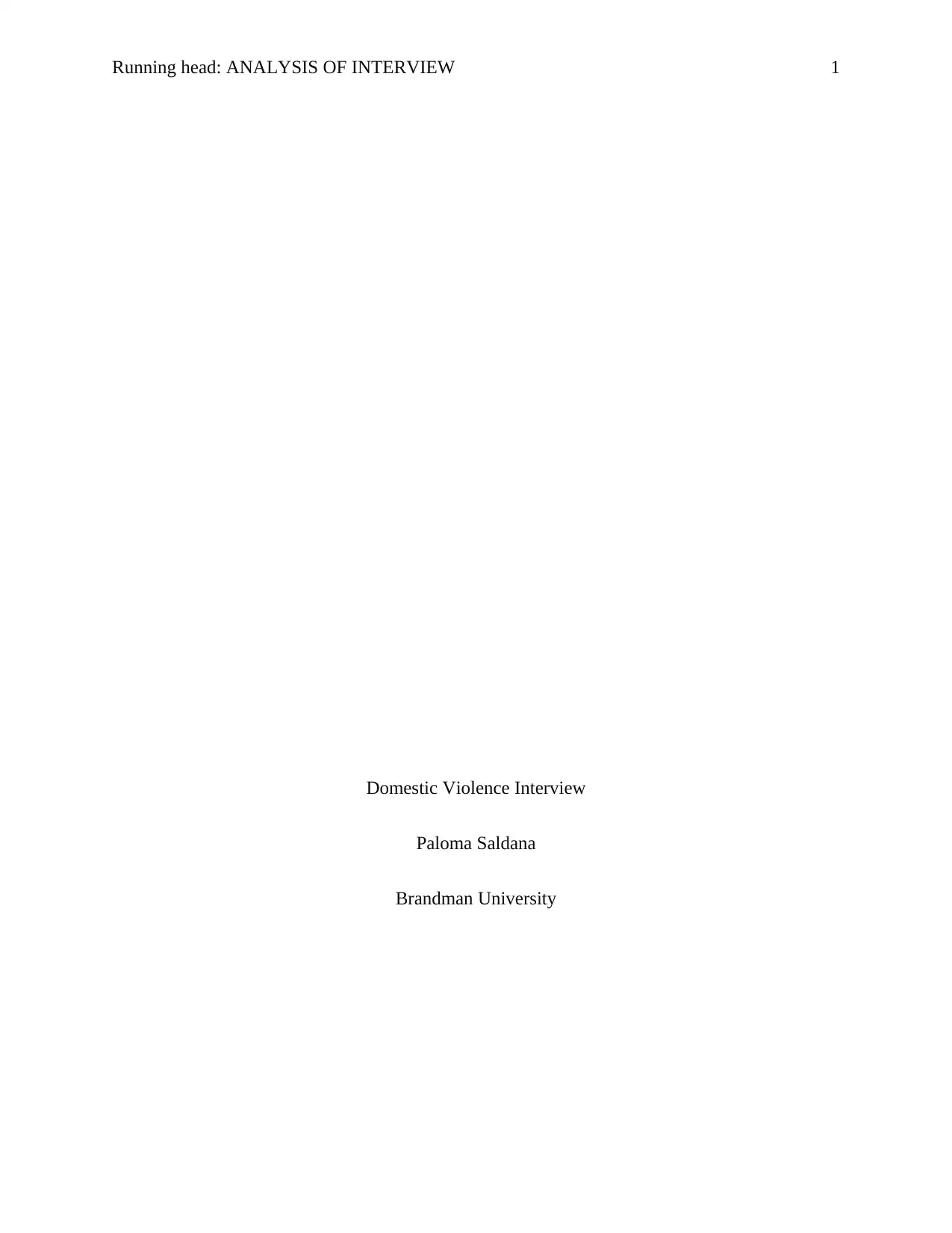
Running head: ANALYSIS OF INTERVIEW 1
Domestic Violence Interview
Paloma Saldana
Brandman University
Domestic Violence Interview
Paloma Saldana
Brandman University
Paraphrase This Document
Need a fresh take? Get an instant paraphrase of this document with our AI Paraphraser
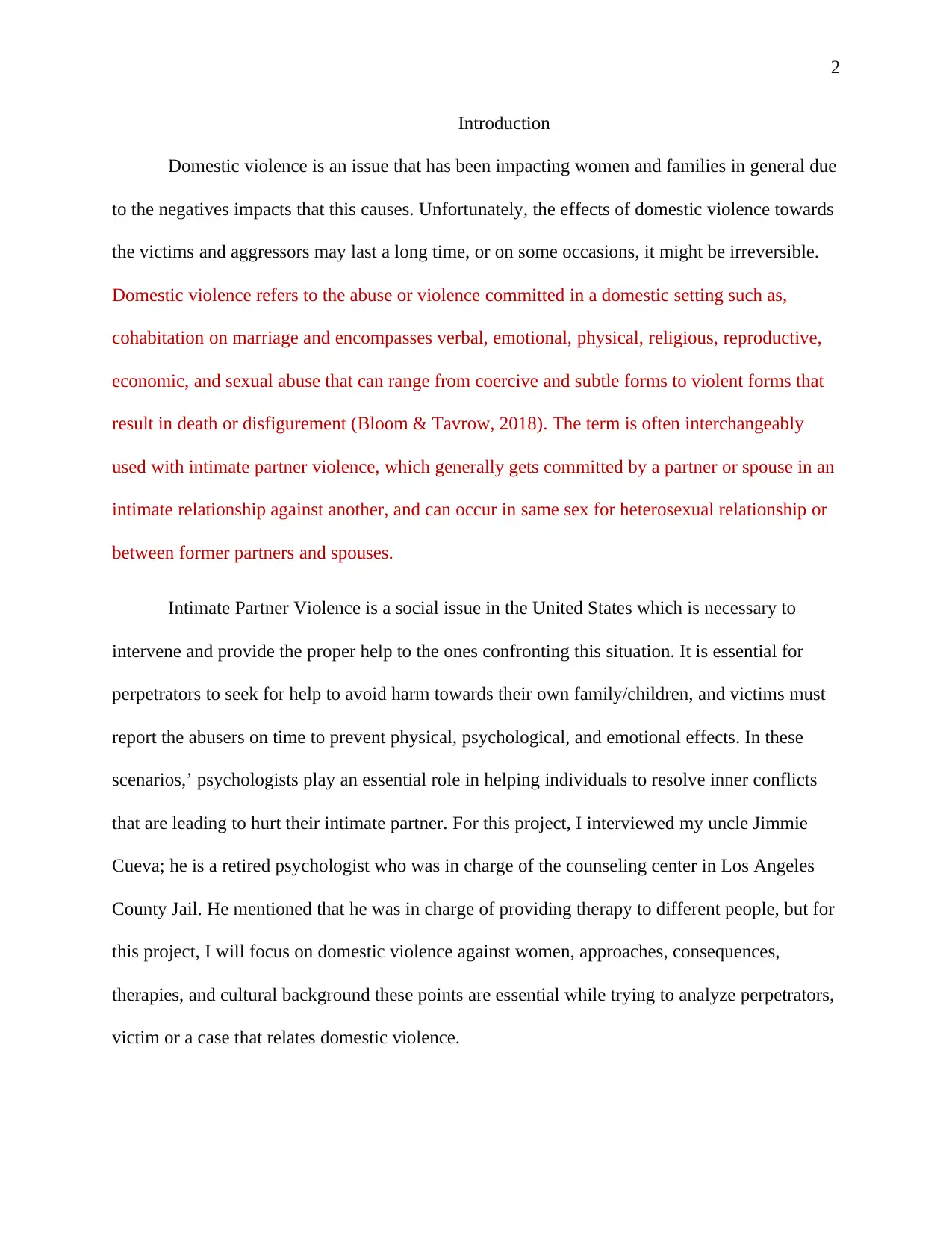
2
Introduction
Domestic violence is an issue that has been impacting women and families in general due
to the negatives impacts that this causes. Unfortunately, the effects of domestic violence towards
the victims and aggressors may last a long time, or on some occasions, it might be irreversible.
Domestic violence refers to the abuse or violence committed in a domestic setting such as,
cohabitation on marriage and encompasses verbal, emotional, physical, religious, reproductive,
economic, and sexual abuse that can range from coercive and subtle forms to violent forms that
result in death or disfigurement (Bloom & Tavrow, 2018). The term is often interchangeably
used with intimate partner violence, which generally gets committed by a partner or spouse in an
intimate relationship against another, and can occur in same sex for heterosexual relationship or
between former partners and spouses.
Intimate Partner Violence is a social issue in the United States which is necessary to
intervene and provide the proper help to the ones confronting this situation. It is essential for
perpetrators to seek for help to avoid harm towards their own family/children, and victims must
report the abusers on time to prevent physical, psychological, and emotional effects. In these
scenarios,’ psychologists play an essential role in helping individuals to resolve inner conflicts
that are leading to hurt their intimate partner. For this project, I interviewed my uncle Jimmie
Cueva; he is a retired psychologist who was in charge of the counseling center in Los Angeles
County Jail. He mentioned that he was in charge of providing therapy to different people, but for
this project, I will focus on domestic violence against women, approaches, consequences,
therapies, and cultural background these points are essential while trying to analyze perpetrators,
victim or a case that relates domestic violence.
Introduction
Domestic violence is an issue that has been impacting women and families in general due
to the negatives impacts that this causes. Unfortunately, the effects of domestic violence towards
the victims and aggressors may last a long time, or on some occasions, it might be irreversible.
Domestic violence refers to the abuse or violence committed in a domestic setting such as,
cohabitation on marriage and encompasses verbal, emotional, physical, religious, reproductive,
economic, and sexual abuse that can range from coercive and subtle forms to violent forms that
result in death or disfigurement (Bloom & Tavrow, 2018). The term is often interchangeably
used with intimate partner violence, which generally gets committed by a partner or spouse in an
intimate relationship against another, and can occur in same sex for heterosexual relationship or
between former partners and spouses.
Intimate Partner Violence is a social issue in the United States which is necessary to
intervene and provide the proper help to the ones confronting this situation. It is essential for
perpetrators to seek for help to avoid harm towards their own family/children, and victims must
report the abusers on time to prevent physical, psychological, and emotional effects. In these
scenarios,’ psychologists play an essential role in helping individuals to resolve inner conflicts
that are leading to hurt their intimate partner. For this project, I interviewed my uncle Jimmie
Cueva; he is a retired psychologist who was in charge of the counseling center in Los Angeles
County Jail. He mentioned that he was in charge of providing therapy to different people, but for
this project, I will focus on domestic violence against women, approaches, consequences,
therapies, and cultural background these points are essential while trying to analyze perpetrators,
victim or a case that relates domestic violence.
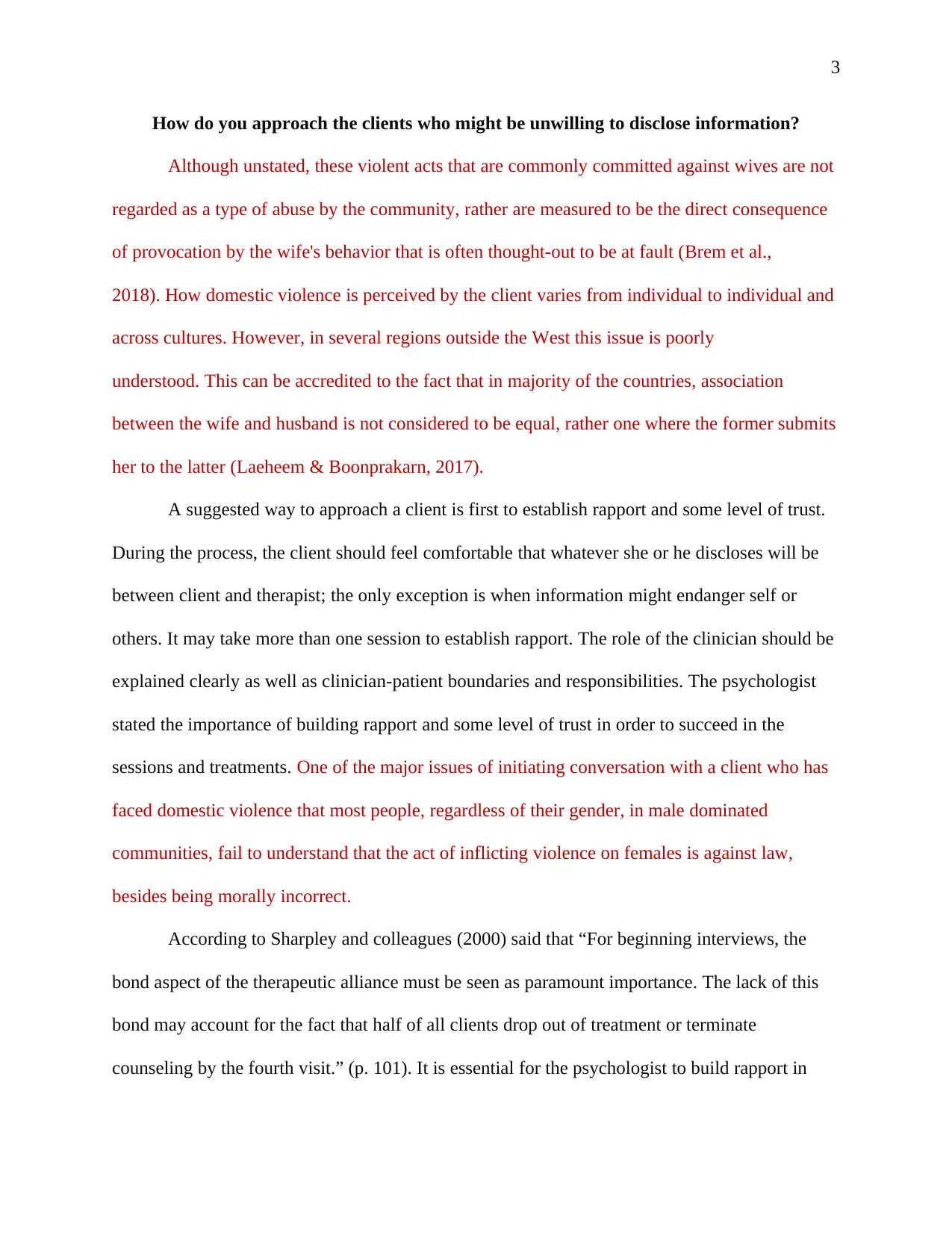
3
How do you approach the clients who might be unwilling to disclose information?
Although unstated, these violent acts that are commonly committed against wives are not
regarded as a type of abuse by the community, rather are measured to be the direct consequence
of provocation by the wife's behavior that is often thought-out to be at fault (Brem et al.,
2018). How domestic violence is perceived by the client varies from individual to individual and
across cultures. However, in several regions outside the West this issue is poorly
understood. This can be accredited to the fact that in majority of the countries, association
between the wife and husband is not considered to be equal, rather one where the former submits
her to the latter (Laeheem & Boonprakarn, 2017).
A suggested way to approach a client is first to establish rapport and some level of trust.
During the process, the client should feel comfortable that whatever she or he discloses will be
between client and therapist; the only exception is when information might endanger self or
others. It may take more than one session to establish rapport. The role of the clinician should be
explained clearly as well as clinician-patient boundaries and responsibilities. The psychologist
stated the importance of building rapport and some level of trust in order to succeed in the
sessions and treatments. One of the major issues of initiating conversation with a client who has
faced domestic violence that most people, regardless of their gender, in male dominated
communities, fail to understand that the act of inflicting violence on females is against law,
besides being morally incorrect.
According to Sharpley and colleagues (2000) said that “For beginning interviews, the
bond aspect of the therapeutic alliance must be seen as paramount importance. The lack of this
bond may account for the fact that half of all clients drop out of treatment or terminate
counseling by the fourth visit.” (p. 101). It is essential for the psychologist to build rapport in
How do you approach the clients who might be unwilling to disclose information?
Although unstated, these violent acts that are commonly committed against wives are not
regarded as a type of abuse by the community, rather are measured to be the direct consequence
of provocation by the wife's behavior that is often thought-out to be at fault (Brem et al.,
2018). How domestic violence is perceived by the client varies from individual to individual and
across cultures. However, in several regions outside the West this issue is poorly
understood. This can be accredited to the fact that in majority of the countries, association
between the wife and husband is not considered to be equal, rather one where the former submits
her to the latter (Laeheem & Boonprakarn, 2017).
A suggested way to approach a client is first to establish rapport and some level of trust.
During the process, the client should feel comfortable that whatever she or he discloses will be
between client and therapist; the only exception is when information might endanger self or
others. It may take more than one session to establish rapport. The role of the clinician should be
explained clearly as well as clinician-patient boundaries and responsibilities. The psychologist
stated the importance of building rapport and some level of trust in order to succeed in the
sessions and treatments. One of the major issues of initiating conversation with a client who has
faced domestic violence that most people, regardless of their gender, in male dominated
communities, fail to understand that the act of inflicting violence on females is against law,
besides being morally incorrect.
According to Sharpley and colleagues (2000) said that “For beginning interviews, the
bond aspect of the therapeutic alliance must be seen as paramount importance. The lack of this
bond may account for the fact that half of all clients drop out of treatment or terminate
counseling by the fourth visit.” (p. 101). It is essential for the psychologist to build rapport in
⊘ This is a preview!⊘
Do you want full access?
Subscribe today to unlock all pages.

Trusted by 1+ million students worldwide
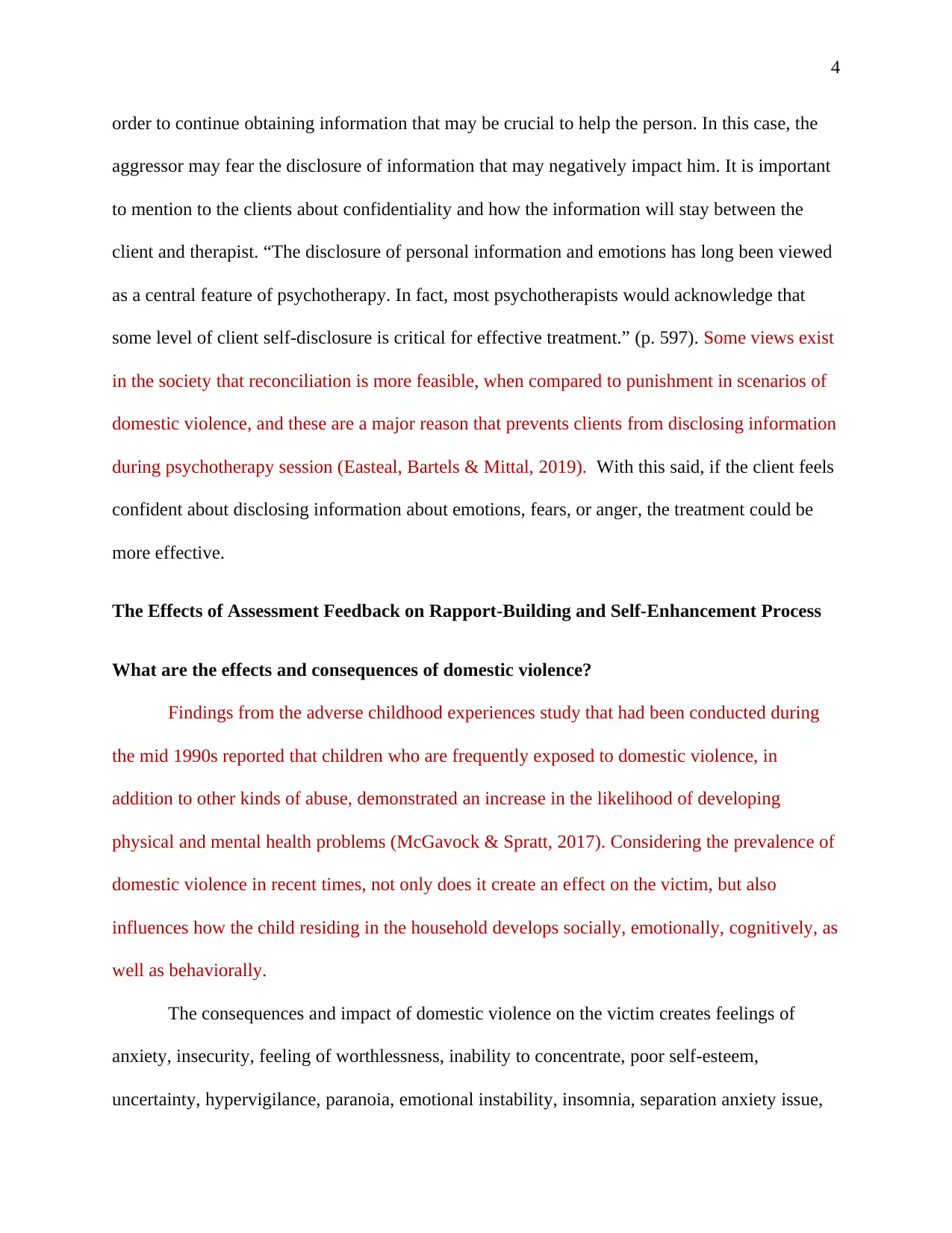
4
order to continue obtaining information that may be crucial to help the person. In this case, the
aggressor may fear the disclosure of information that may negatively impact him. It is important
to mention to the clients about confidentiality and how the information will stay between the
client and therapist. “The disclosure of personal information and emotions has long been viewed
as a central feature of psychotherapy. In fact, most psychotherapists would acknowledge that
some level of client self-disclosure is critical for effective treatment.” (p. 597). Some views exist
in the society that reconciliation is more feasible, when compared to punishment in scenarios of
domestic violence, and these are a major reason that prevents clients from disclosing information
during psychotherapy session (Easteal, Bartels & Mittal, 2019). With this said, if the client feels
confident about disclosing information about emotions, fears, or anger, the treatment could be
more effective.
The Effects of Assessment Feedback on Rapport-Building and Self-Enhancement Process
What are the effects and consequences of domestic violence?
Findings from the adverse childhood experiences study that had been conducted during
the mid 1990s reported that children who are frequently exposed to domestic violence, in
addition to other kinds of abuse, demonstrated an increase in the likelihood of developing
physical and mental health problems (McGavock & Spratt, 2017). Considering the prevalence of
domestic violence in recent times, not only does it create an effect on the victim, but also
influences how the child residing in the household develops socially, emotionally, cognitively, as
well as behaviorally.
The consequences and impact of domestic violence on the victim creates feelings of
anxiety, insecurity, feeling of worthlessness, inability to concentrate, poor self-esteem,
uncertainty, hypervigilance, paranoia, emotional instability, insomnia, separation anxiety issue,
order to continue obtaining information that may be crucial to help the person. In this case, the
aggressor may fear the disclosure of information that may negatively impact him. It is important
to mention to the clients about confidentiality and how the information will stay between the
client and therapist. “The disclosure of personal information and emotions has long been viewed
as a central feature of psychotherapy. In fact, most psychotherapists would acknowledge that
some level of client self-disclosure is critical for effective treatment.” (p. 597). Some views exist
in the society that reconciliation is more feasible, when compared to punishment in scenarios of
domestic violence, and these are a major reason that prevents clients from disclosing information
during psychotherapy session (Easteal, Bartels & Mittal, 2019). With this said, if the client feels
confident about disclosing information about emotions, fears, or anger, the treatment could be
more effective.
The Effects of Assessment Feedback on Rapport-Building and Self-Enhancement Process
What are the effects and consequences of domestic violence?
Findings from the adverse childhood experiences study that had been conducted during
the mid 1990s reported that children who are frequently exposed to domestic violence, in
addition to other kinds of abuse, demonstrated an increase in the likelihood of developing
physical and mental health problems (McGavock & Spratt, 2017). Considering the prevalence of
domestic violence in recent times, not only does it create an effect on the victim, but also
influences how the child residing in the household develops socially, emotionally, cognitively, as
well as behaviorally.
The consequences and impact of domestic violence on the victim creates feelings of
anxiety, insecurity, feeling of worthlessness, inability to concentrate, poor self-esteem,
uncertainty, hypervigilance, paranoia, emotional instability, insomnia, separation anxiety issue,
Paraphrase This Document
Need a fresh take? Get an instant paraphrase of this document with our AI Paraphraser
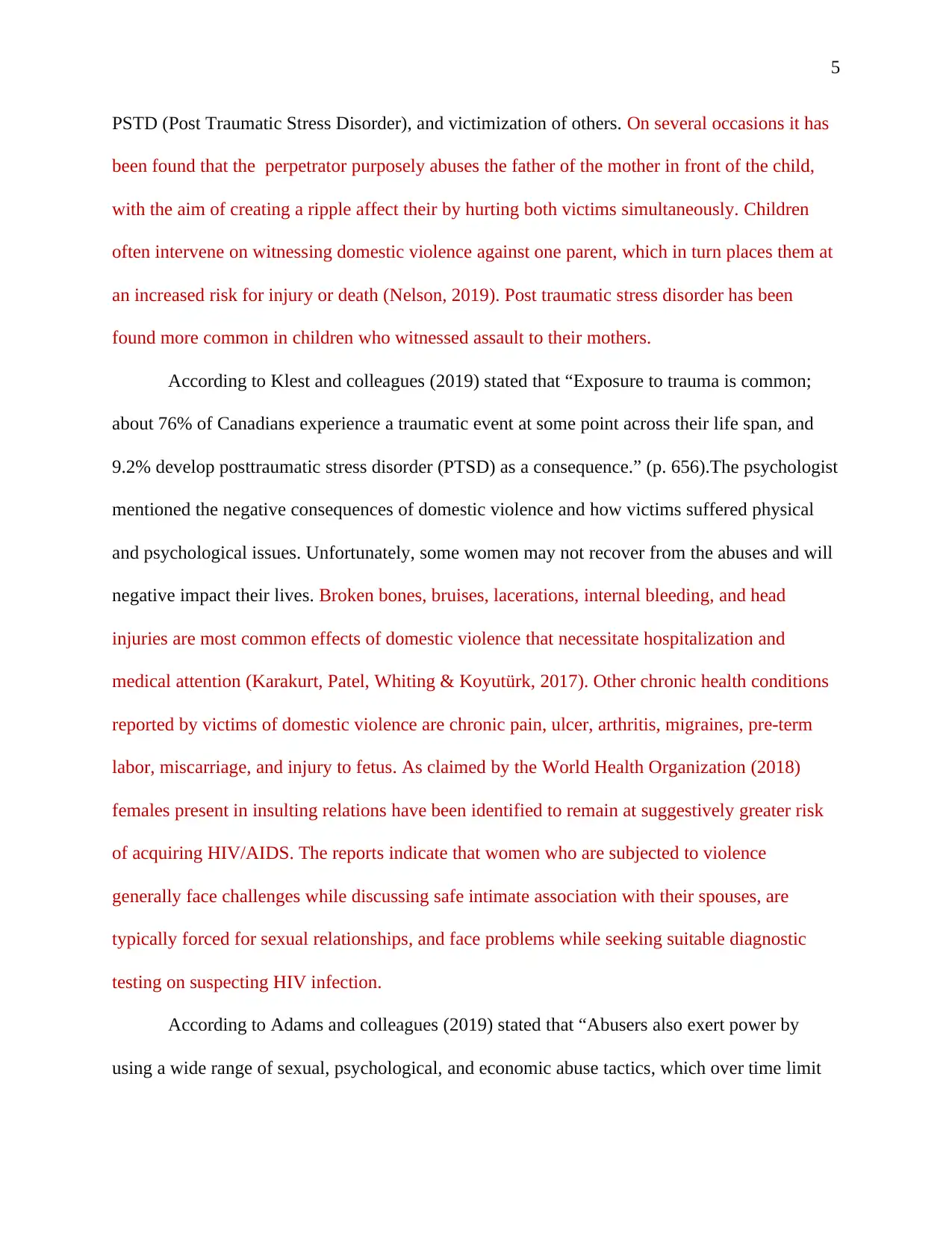
5
PSTD (Post Traumatic Stress Disorder), and victimization of others. On several occasions it has
been found that the perpetrator purposely abuses the father of the mother in front of the child,
with the aim of creating a ripple affect their by hurting both victims simultaneously. Children
often intervene on witnessing domestic violence against one parent, which in turn places them at
an increased risk for injury or death (Nelson, 2019). Post traumatic stress disorder has been
found more common in children who witnessed assault to their mothers.
According to Klest and colleagues (2019) stated that “Exposure to trauma is common;
about 76% of Canadians experience a traumatic event at some point across their life span, and
9.2% develop posttraumatic stress disorder (PTSD) as a consequence.” (p. 656).The psychologist
mentioned the negative consequences of domestic violence and how victims suffered physical
and psychological issues. Unfortunately, some women may not recover from the abuses and will
negative impact their lives. Broken bones, bruises, lacerations, internal bleeding, and head
injuries are most common effects of domestic violence that necessitate hospitalization and
medical attention (Karakurt, Patel, Whiting & Koyutürk, 2017). Other chronic health conditions
reported by victims of domestic violence are chronic pain, ulcer, arthritis, migraines, pre-term
labor, miscarriage, and injury to fetus. As claimed by the World Health Organization (2018)
females present in insulting relations have been identified to remain at suggestively greater risk
of acquiring HIV/AIDS. The reports indicate that women who are subjected to violence
generally face challenges while discussing safe intimate association with their spouses, are
typically forced for sexual relationships, and face problems while seeking suitable diagnostic
testing on suspecting HIV infection.
According to Adams and colleagues (2019) stated that “Abusers also exert power by
using a wide range of sexual, psychological, and economic abuse tactics, which over time limit
PSTD (Post Traumatic Stress Disorder), and victimization of others. On several occasions it has
been found that the perpetrator purposely abuses the father of the mother in front of the child,
with the aim of creating a ripple affect their by hurting both victims simultaneously. Children
often intervene on witnessing domestic violence against one parent, which in turn places them at
an increased risk for injury or death (Nelson, 2019). Post traumatic stress disorder has been
found more common in children who witnessed assault to their mothers.
According to Klest and colleagues (2019) stated that “Exposure to trauma is common;
about 76% of Canadians experience a traumatic event at some point across their life span, and
9.2% develop posttraumatic stress disorder (PTSD) as a consequence.” (p. 656).The psychologist
mentioned the negative consequences of domestic violence and how victims suffered physical
and psychological issues. Unfortunately, some women may not recover from the abuses and will
negative impact their lives. Broken bones, bruises, lacerations, internal bleeding, and head
injuries are most common effects of domestic violence that necessitate hospitalization and
medical attention (Karakurt, Patel, Whiting & Koyutürk, 2017). Other chronic health conditions
reported by victims of domestic violence are chronic pain, ulcer, arthritis, migraines, pre-term
labor, miscarriage, and injury to fetus. As claimed by the World Health Organization (2018)
females present in insulting relations have been identified to remain at suggestively greater risk
of acquiring HIV/AIDS. The reports indicate that women who are subjected to violence
generally face challenges while discussing safe intimate association with their spouses, are
typically forced for sexual relationships, and face problems while seeking suitable diagnostic
testing on suspecting HIV infection.
According to Adams and colleagues (2019) stated that “Abusers also exert power by
using a wide range of sexual, psychological, and economic abuse tactics, which over time limit
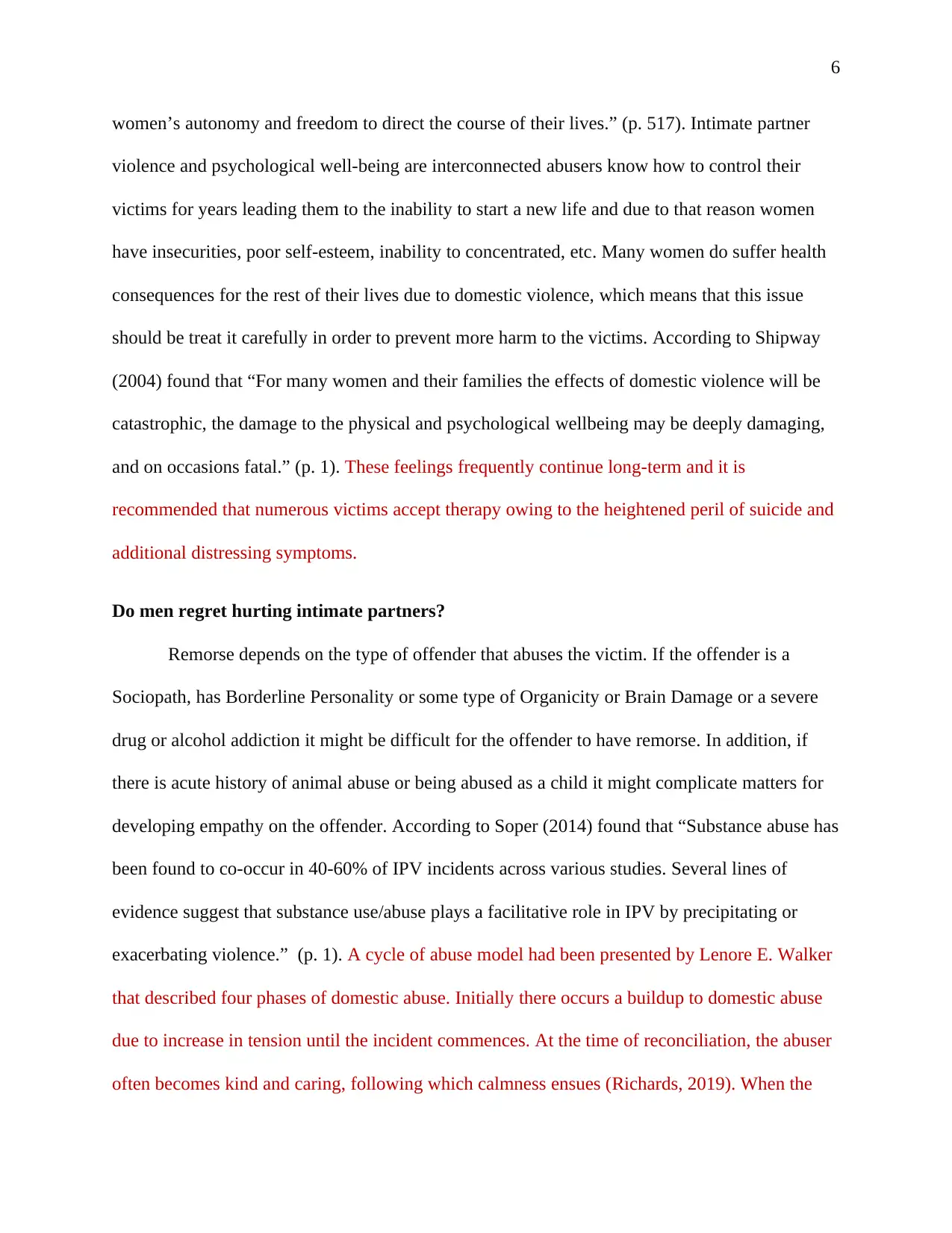
6
women’s autonomy and freedom to direct the course of their lives.” (p. 517). Intimate partner
violence and psychological well-being are interconnected abusers know how to control their
victims for years leading them to the inability to start a new life and due to that reason women
have insecurities, poor self-esteem, inability to concentrated, etc. Many women do suffer health
consequences for the rest of their lives due to domestic violence, which means that this issue
should be treat it carefully in order to prevent more harm to the victims. According to Shipway
(2004) found that “For many women and their families the effects of domestic violence will be
catastrophic, the damage to the physical and psychological wellbeing may be deeply damaging,
and on occasions fatal.” (p. 1). These feelings frequently continue long-term and it is
recommended that numerous victims accept therapy owing to the heightened peril of suicide and
additional distressing symptoms.
Do men regret hurting intimate partners?
Remorse depends on the type of offender that abuses the victim. If the offender is a
Sociopath, has Borderline Personality or some type of Organicity or Brain Damage or a severe
drug or alcohol addiction it might be difficult for the offender to have remorse. In addition, if
there is acute history of animal abuse or being abused as a child it might complicate matters for
developing empathy on the offender. According to Soper (2014) found that “Substance abuse has
been found to co-occur in 40-60% of IPV incidents across various studies. Several lines of
evidence suggest that substance use/abuse plays a facilitative role in IPV by precipitating or
exacerbating violence.” (p. 1). A cycle of abuse model had been presented by Lenore E. Walker
that described four phases of domestic abuse. Initially there occurs a buildup to domestic abuse
due to increase in tension until the incident commences. At the time of reconciliation, the abuser
often becomes kind and caring, following which calmness ensues (Richards, 2019). When the
women’s autonomy and freedom to direct the course of their lives.” (p. 517). Intimate partner
violence and psychological well-being are interconnected abusers know how to control their
victims for years leading them to the inability to start a new life and due to that reason women
have insecurities, poor self-esteem, inability to concentrated, etc. Many women do suffer health
consequences for the rest of their lives due to domestic violence, which means that this issue
should be treat it carefully in order to prevent more harm to the victims. According to Shipway
(2004) found that “For many women and their families the effects of domestic violence will be
catastrophic, the damage to the physical and psychological wellbeing may be deeply damaging,
and on occasions fatal.” (p. 1). These feelings frequently continue long-term and it is
recommended that numerous victims accept therapy owing to the heightened peril of suicide and
additional distressing symptoms.
Do men regret hurting intimate partners?
Remorse depends on the type of offender that abuses the victim. If the offender is a
Sociopath, has Borderline Personality or some type of Organicity or Brain Damage or a severe
drug or alcohol addiction it might be difficult for the offender to have remorse. In addition, if
there is acute history of animal abuse or being abused as a child it might complicate matters for
developing empathy on the offender. According to Soper (2014) found that “Substance abuse has
been found to co-occur in 40-60% of IPV incidents across various studies. Several lines of
evidence suggest that substance use/abuse plays a facilitative role in IPV by precipitating or
exacerbating violence.” (p. 1). A cycle of abuse model had been presented by Lenore E. Walker
that described four phases of domestic abuse. Initially there occurs a buildup to domestic abuse
due to increase in tension until the incident commences. At the time of reconciliation, the abuser
often becomes kind and caring, following which calmness ensues (Richards, 2019). When the
⊘ This is a preview!⊘
Do you want full access?
Subscribe today to unlock all pages.

Trusted by 1+ million students worldwide
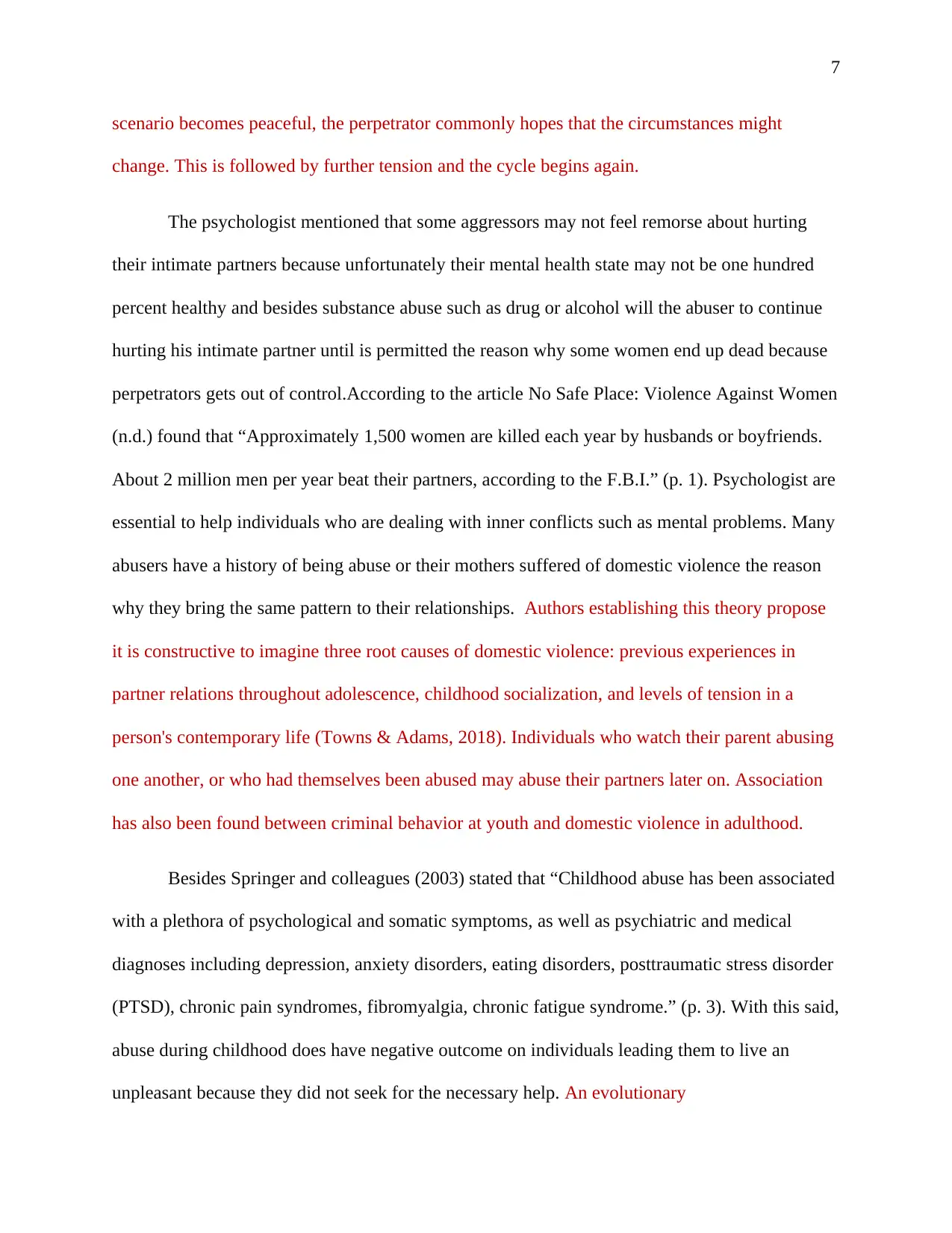
7
scenario becomes peaceful, the perpetrator commonly hopes that the circumstances might
change. This is followed by further tension and the cycle begins again.
The psychologist mentioned that some aggressors may not feel remorse about hurting
their intimate partners because unfortunately their mental health state may not be one hundred
percent healthy and besides substance abuse such as drug or alcohol will the abuser to continue
hurting his intimate partner until is permitted the reason why some women end up dead because
perpetrators gets out of control.According to the article No Safe Place: Violence Against Women
(n.d.) found that “Approximately 1,500 women are killed each year by husbands or boyfriends.
About 2 million men per year beat their partners, according to the F.B.I.” (p. 1). Psychologist are
essential to help individuals who are dealing with inner conflicts such as mental problems. Many
abusers have a history of being abuse or their mothers suffered of domestic violence the reason
why they bring the same pattern to their relationships. Authors establishing this theory propose
it is constructive to imagine three root causes of domestic violence: previous experiences in
partner relations throughout adolescence, childhood socialization, and levels of tension in a
person's contemporary life (Towns & Adams, 2018). Individuals who watch their parent abusing
one another, or who had themselves been abused may abuse their partners later on. Association
has also been found between criminal behavior at youth and domestic violence in adulthood.
Besides Springer and colleagues (2003) stated that “Childhood abuse has been associated
with a plethora of psychological and somatic symptoms, as well as psychiatric and medical
diagnoses including depression, anxiety disorders, eating disorders, posttraumatic stress disorder
(PTSD), chronic pain syndromes, fibromyalgia, chronic fatigue syndrome.” (p. 3). With this said,
abuse during childhood does have negative outcome on individuals leading them to live an
unpleasant because they did not seek for the necessary help. An evolutionary
scenario becomes peaceful, the perpetrator commonly hopes that the circumstances might
change. This is followed by further tension and the cycle begins again.
The psychologist mentioned that some aggressors may not feel remorse about hurting
their intimate partners because unfortunately their mental health state may not be one hundred
percent healthy and besides substance abuse such as drug or alcohol will the abuser to continue
hurting his intimate partner until is permitted the reason why some women end up dead because
perpetrators gets out of control.According to the article No Safe Place: Violence Against Women
(n.d.) found that “Approximately 1,500 women are killed each year by husbands or boyfriends.
About 2 million men per year beat their partners, according to the F.B.I.” (p. 1). Psychologist are
essential to help individuals who are dealing with inner conflicts such as mental problems. Many
abusers have a history of being abuse or their mothers suffered of domestic violence the reason
why they bring the same pattern to their relationships. Authors establishing this theory propose
it is constructive to imagine three root causes of domestic violence: previous experiences in
partner relations throughout adolescence, childhood socialization, and levels of tension in a
person's contemporary life (Towns & Adams, 2018). Individuals who watch their parent abusing
one another, or who had themselves been abused may abuse their partners later on. Association
has also been found between criminal behavior at youth and domestic violence in adulthood.
Besides Springer and colleagues (2003) stated that “Childhood abuse has been associated
with a plethora of psychological and somatic symptoms, as well as psychiatric and medical
diagnoses including depression, anxiety disorders, eating disorders, posttraumatic stress disorder
(PTSD), chronic pain syndromes, fibromyalgia, chronic fatigue syndrome.” (p. 3). With this said,
abuse during childhood does have negative outcome on individuals leading them to live an
unpleasant because they did not seek for the necessary help. An evolutionary
Paraphrase This Document
Need a fresh take? Get an instant paraphrase of this document with our AI Paraphraser
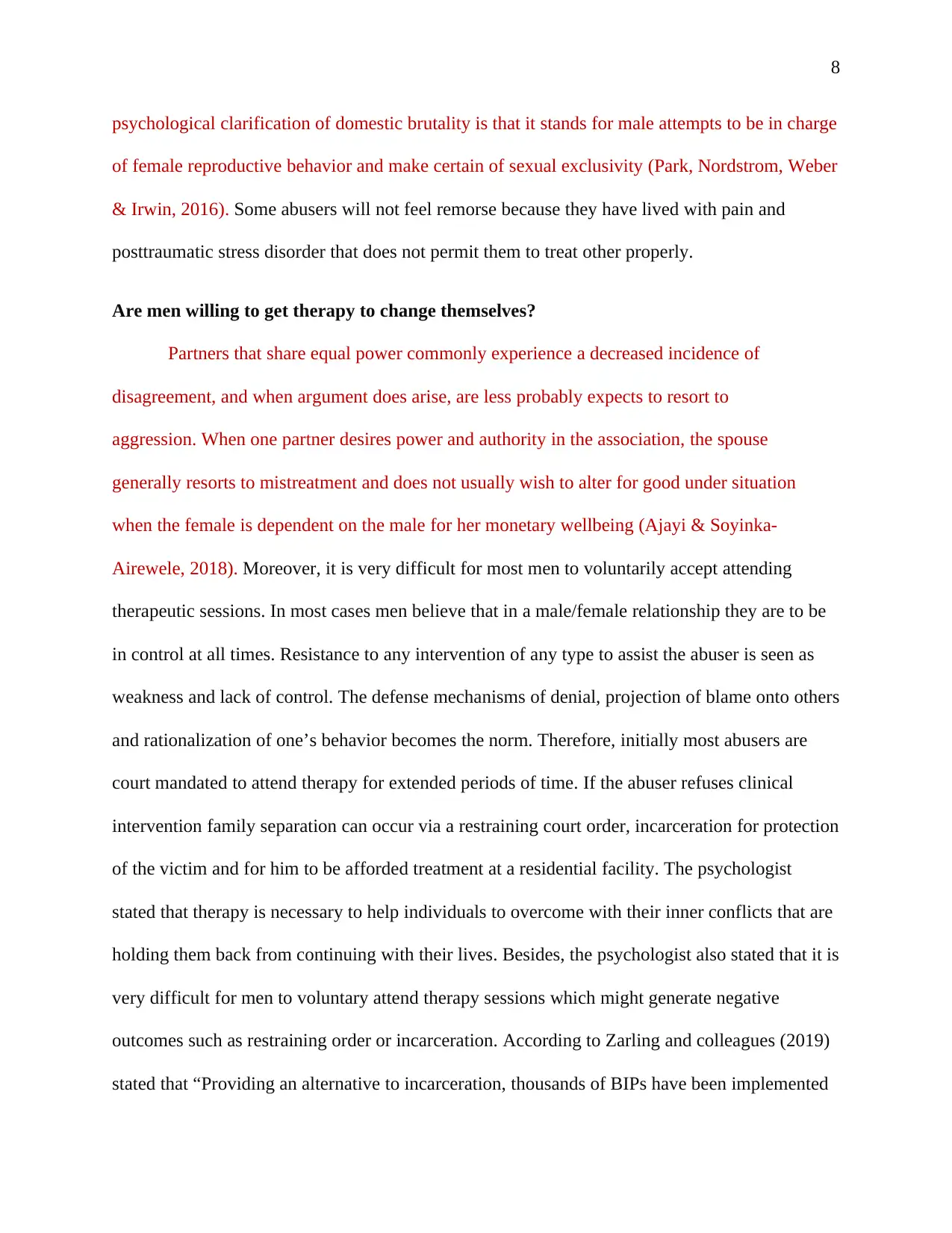
8
psychological clarification of domestic brutality is that it stands for male attempts to be in charge
of female reproductive behavior and make certain of sexual exclusivity (Park, Nordstrom, Weber
& Irwin, 2016). Some abusers will not feel remorse because they have lived with pain and
posttraumatic stress disorder that does not permit them to treat other properly.
Are men willing to get therapy to change themselves?
Partners that share equal power commonly experience a decreased incidence of
disagreement, and when argument does arise, are less probably expects to resort to
aggression. When one partner desires power and authority in the association, the spouse
generally resorts to mistreatment and does not usually wish to alter for good under situation
when the female is dependent on the male for her monetary wellbeing (Ajayi & Soyinka-
Airewele, 2018). Moreover, it is very difficult for most men to voluntarily accept attending
therapeutic sessions. In most cases men believe that in a male/female relationship they are to be
in control at all times. Resistance to any intervention of any type to assist the abuser is seen as
weakness and lack of control. The defense mechanisms of denial, projection of blame onto others
and rationalization of one’s behavior becomes the norm. Therefore, initially most abusers are
court mandated to attend therapy for extended periods of time. If the abuser refuses clinical
intervention family separation can occur via a restraining court order, incarceration for protection
of the victim and for him to be afforded treatment at a residential facility. The psychologist
stated that therapy is necessary to help individuals to overcome with their inner conflicts that are
holding them back from continuing with their lives. Besides, the psychologist also stated that it is
very difficult for men to voluntary attend therapy sessions which might generate negative
outcomes such as restraining order or incarceration. According to Zarling and colleagues (2019)
stated that “Providing an alternative to incarceration, thousands of BIPs have been implemented
psychological clarification of domestic brutality is that it stands for male attempts to be in charge
of female reproductive behavior and make certain of sexual exclusivity (Park, Nordstrom, Weber
& Irwin, 2016). Some abusers will not feel remorse because they have lived with pain and
posttraumatic stress disorder that does not permit them to treat other properly.
Are men willing to get therapy to change themselves?
Partners that share equal power commonly experience a decreased incidence of
disagreement, and when argument does arise, are less probably expects to resort to
aggression. When one partner desires power and authority in the association, the spouse
generally resorts to mistreatment and does not usually wish to alter for good under situation
when the female is dependent on the male for her monetary wellbeing (Ajayi & Soyinka-
Airewele, 2018). Moreover, it is very difficult for most men to voluntarily accept attending
therapeutic sessions. In most cases men believe that in a male/female relationship they are to be
in control at all times. Resistance to any intervention of any type to assist the abuser is seen as
weakness and lack of control. The defense mechanisms of denial, projection of blame onto others
and rationalization of one’s behavior becomes the norm. Therefore, initially most abusers are
court mandated to attend therapy for extended periods of time. If the abuser refuses clinical
intervention family separation can occur via a restraining court order, incarceration for protection
of the victim and for him to be afforded treatment at a residential facility. The psychologist
stated that therapy is necessary to help individuals to overcome with their inner conflicts that are
holding them back from continuing with their lives. Besides, the psychologist also stated that it is
very difficult for men to voluntary attend therapy sessions which might generate negative
outcomes such as restraining order or incarceration. According to Zarling and colleagues (2019)
stated that “Providing an alternative to incarceration, thousands of BIPs have been implemented
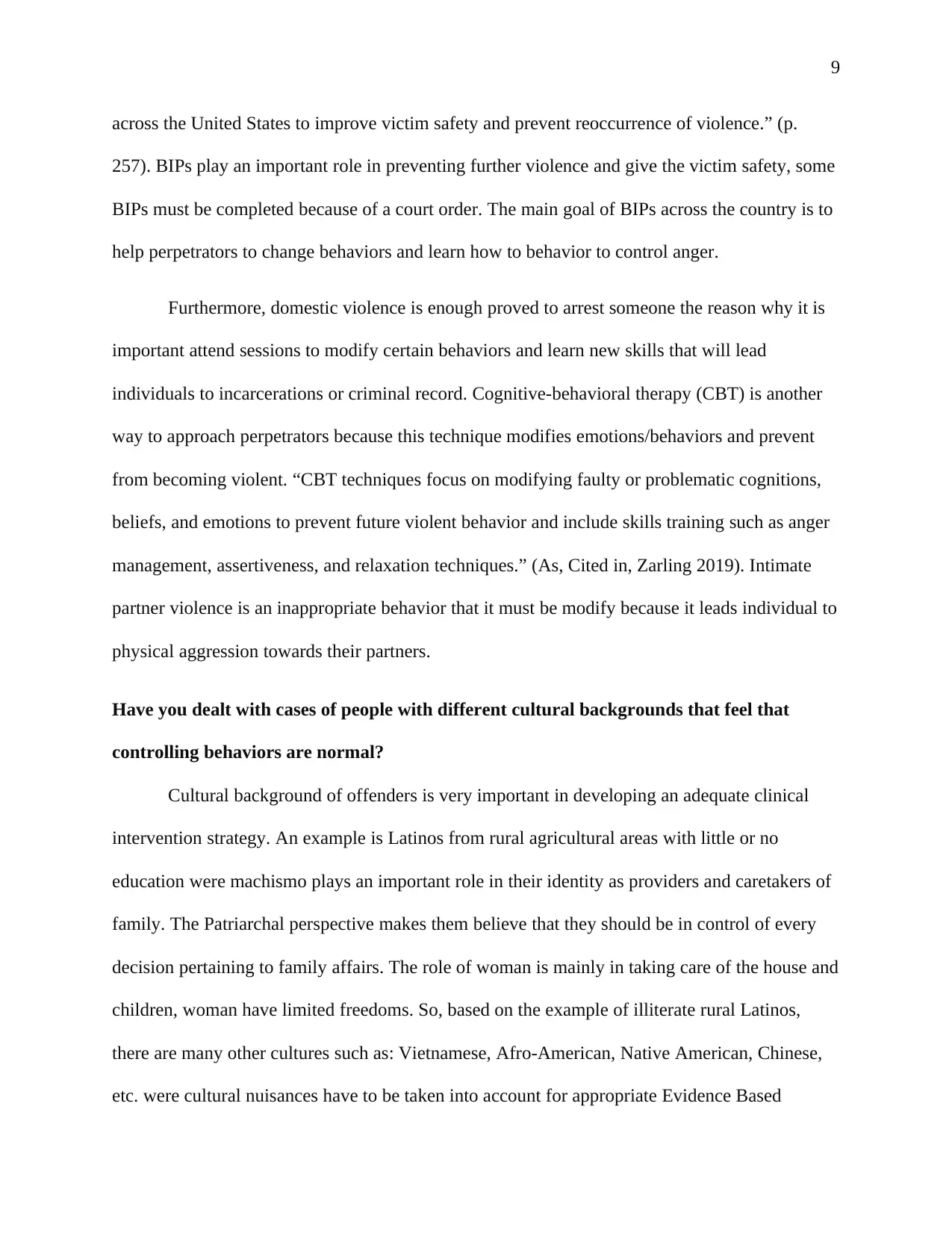
9
across the United States to improve victim safety and prevent reoccurrence of violence.” (p.
257). BIPs play an important role in preventing further violence and give the victim safety, some
BIPs must be completed because of a court order. The main goal of BIPs across the country is to
help perpetrators to change behaviors and learn how to behavior to control anger.
Furthermore, domestic violence is enough proved to arrest someone the reason why it is
important attend sessions to modify certain behaviors and learn new skills that will lead
individuals to incarcerations or criminal record. Cognitive-behavioral therapy (CBT) is another
way to approach perpetrators because this technique modifies emotions/behaviors and prevent
from becoming violent. “CBT techniques focus on modifying faulty or problematic cognitions,
beliefs, and emotions to prevent future violent behavior and include skills training such as anger
management, assertiveness, and relaxation techniques.” (As, Cited in, Zarling 2019). Intimate
partner violence is an inappropriate behavior that it must be modify because it leads individual to
physical aggression towards their partners.
Have you dealt with cases of people with different cultural backgrounds that feel that
controlling behaviors are normal?
Cultural background of offenders is very important in developing an adequate clinical
intervention strategy. An example is Latinos from rural agricultural areas with little or no
education were machismo plays an important role in their identity as providers and caretakers of
family. The Patriarchal perspective makes them believe that they should be in control of every
decision pertaining to family affairs. The role of woman is mainly in taking care of the house and
children, woman have limited freedoms. So, based on the example of illiterate rural Latinos,
there are many other cultures such as: Vietnamese, Afro-American, Native American, Chinese,
etc. were cultural nuisances have to be taken into account for appropriate Evidence Based
across the United States to improve victim safety and prevent reoccurrence of violence.” (p.
257). BIPs play an important role in preventing further violence and give the victim safety, some
BIPs must be completed because of a court order. The main goal of BIPs across the country is to
help perpetrators to change behaviors and learn how to behavior to control anger.
Furthermore, domestic violence is enough proved to arrest someone the reason why it is
important attend sessions to modify certain behaviors and learn new skills that will lead
individuals to incarcerations or criminal record. Cognitive-behavioral therapy (CBT) is another
way to approach perpetrators because this technique modifies emotions/behaviors and prevent
from becoming violent. “CBT techniques focus on modifying faulty or problematic cognitions,
beliefs, and emotions to prevent future violent behavior and include skills training such as anger
management, assertiveness, and relaxation techniques.” (As, Cited in, Zarling 2019). Intimate
partner violence is an inappropriate behavior that it must be modify because it leads individual to
physical aggression towards their partners.
Have you dealt with cases of people with different cultural backgrounds that feel that
controlling behaviors are normal?
Cultural background of offenders is very important in developing an adequate clinical
intervention strategy. An example is Latinos from rural agricultural areas with little or no
education were machismo plays an important role in their identity as providers and caretakers of
family. The Patriarchal perspective makes them believe that they should be in control of every
decision pertaining to family affairs. The role of woman is mainly in taking care of the house and
children, woman have limited freedoms. So, based on the example of illiterate rural Latinos,
there are many other cultures such as: Vietnamese, Afro-American, Native American, Chinese,
etc. were cultural nuisances have to be taken into account for appropriate Evidence Based
⊘ This is a preview!⊘
Do you want full access?
Subscribe today to unlock all pages.

Trusted by 1+ million students worldwide
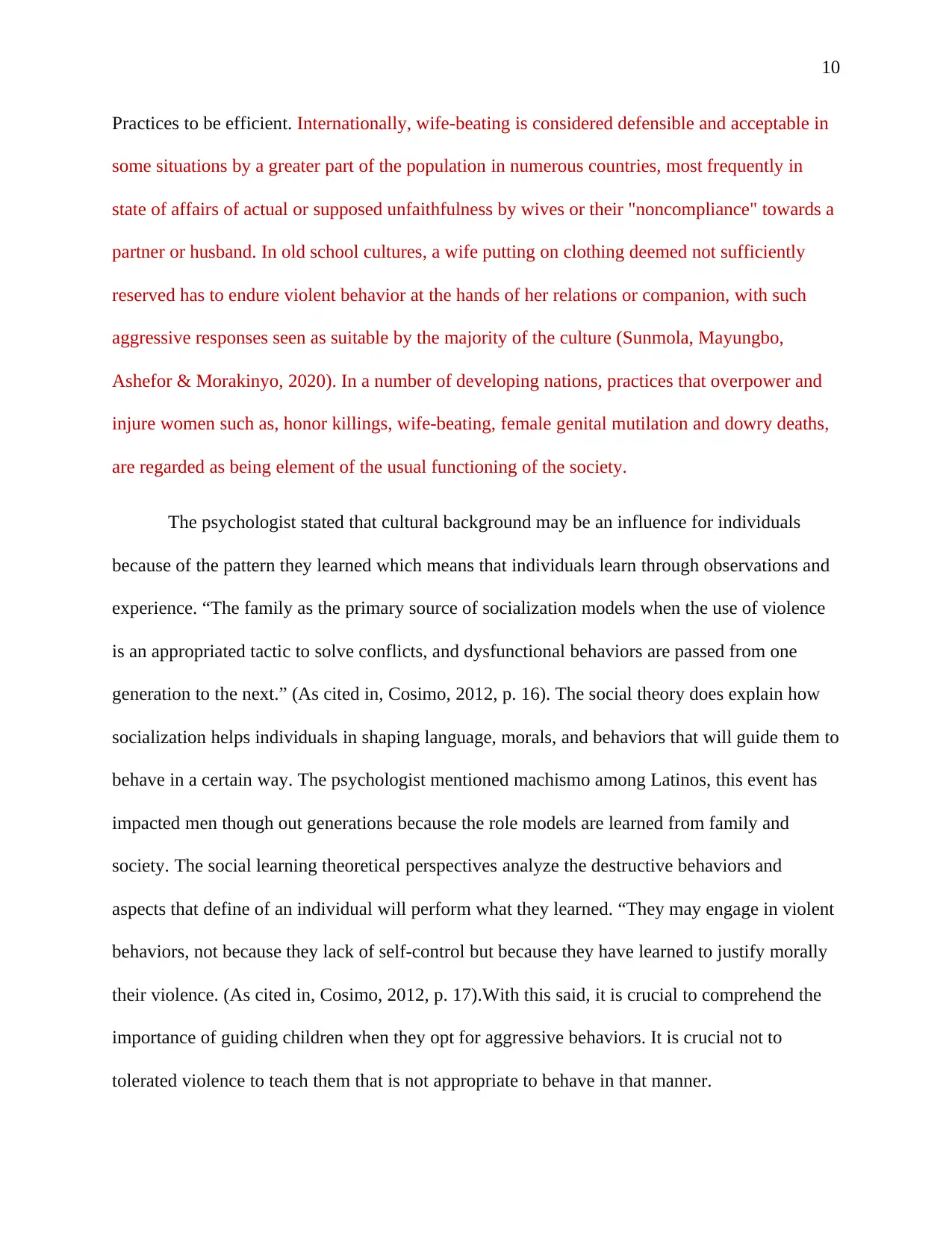
10
Practices to be efficient. Internationally, wife-beating is considered defensible and acceptable in
some situations by a greater part of the population in numerous countries, most frequently in
state of affairs of actual or supposed unfaithfulness by wives or their "noncompliance" towards a
partner or husband. In old school cultures, a wife putting on clothing deemed not sufficiently
reserved has to endure violent behavior at the hands of her relations or companion, with such
aggressive responses seen as suitable by the majority of the culture (Sunmola, Mayungbo,
Ashefor & Morakinyo, 2020). In a number of developing nations, practices that overpower and
injure women such as, honor killings, wife-beating, female genital mutilation and dowry deaths,
are regarded as being element of the usual functioning of the society.
The psychologist stated that cultural background may be an influence for individuals
because of the pattern they learned which means that individuals learn through observations and
experience. “The family as the primary source of socialization models when the use of violence
is an appropriated tactic to solve conflicts, and dysfunctional behaviors are passed from one
generation to the next.” (As cited in, Cosimo, 2012, p. 16). The social theory does explain how
socialization helps individuals in shaping language, morals, and behaviors that will guide them to
behave in a certain way. The psychologist mentioned machismo among Latinos, this event has
impacted men though out generations because the role models are learned from family and
society. The social learning theoretical perspectives analyze the destructive behaviors and
aspects that define of an individual will perform what they learned. “They may engage in violent
behaviors, not because they lack of self-control but because they have learned to justify morally
their violence. (As cited in, Cosimo, 2012, p. 17).With this said, it is crucial to comprehend the
importance of guiding children when they opt for aggressive behaviors. It is crucial not to
tolerated violence to teach them that is not appropriate to behave in that manner.
Practices to be efficient. Internationally, wife-beating is considered defensible and acceptable in
some situations by a greater part of the population in numerous countries, most frequently in
state of affairs of actual or supposed unfaithfulness by wives or their "noncompliance" towards a
partner or husband. In old school cultures, a wife putting on clothing deemed not sufficiently
reserved has to endure violent behavior at the hands of her relations or companion, with such
aggressive responses seen as suitable by the majority of the culture (Sunmola, Mayungbo,
Ashefor & Morakinyo, 2020). In a number of developing nations, practices that overpower and
injure women such as, honor killings, wife-beating, female genital mutilation and dowry deaths,
are regarded as being element of the usual functioning of the society.
The psychologist stated that cultural background may be an influence for individuals
because of the pattern they learned which means that individuals learn through observations and
experience. “The family as the primary source of socialization models when the use of violence
is an appropriated tactic to solve conflicts, and dysfunctional behaviors are passed from one
generation to the next.” (As cited in, Cosimo, 2012, p. 16). The social theory does explain how
socialization helps individuals in shaping language, morals, and behaviors that will guide them to
behave in a certain way. The psychologist mentioned machismo among Latinos, this event has
impacted men though out generations because the role models are learned from family and
society. The social learning theoretical perspectives analyze the destructive behaviors and
aspects that define of an individual will perform what they learned. “They may engage in violent
behaviors, not because they lack of self-control but because they have learned to justify morally
their violence. (As cited in, Cosimo, 2012, p. 17).With this said, it is crucial to comprehend the
importance of guiding children when they opt for aggressive behaviors. It is crucial not to
tolerated violence to teach them that is not appropriate to behave in that manner.
Paraphrase This Document
Need a fresh take? Get an instant paraphrase of this document with our AI Paraphraser
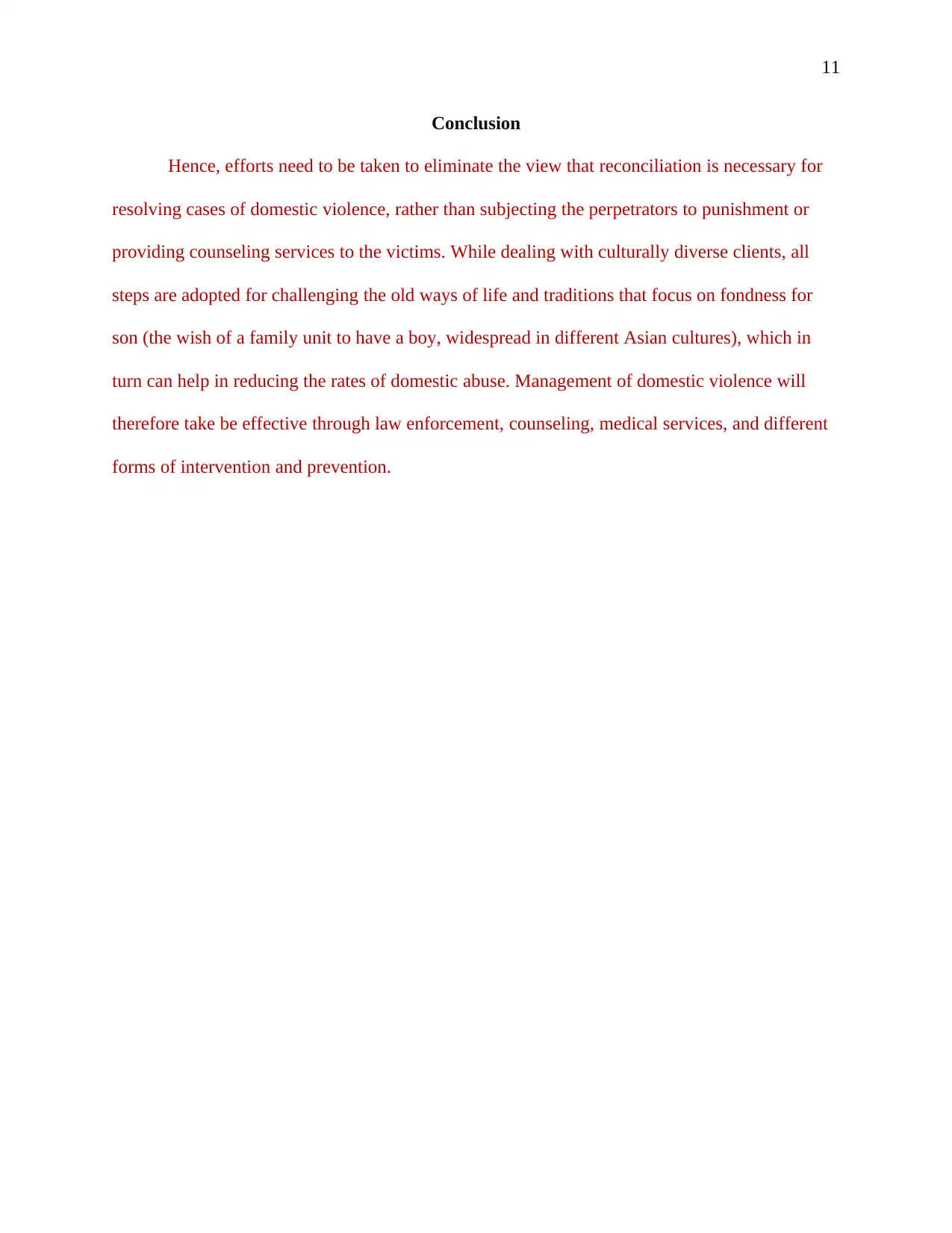
11
Conclusion
Hence, efforts need to be taken to eliminate the view that reconciliation is necessary for
resolving cases of domestic violence, rather than subjecting the perpetrators to punishment or
providing counseling services to the victims. While dealing with culturally diverse clients, all
steps are adopted for challenging the old ways of life and traditions that focus on fondness for
son (the wish of a family unit to have a boy, widespread in different Asian cultures), which in
turn can help in reducing the rates of domestic abuse. Management of domestic violence will
therefore take be effective through law enforcement, counseling, medical services, and different
forms of intervention and prevention.
Conclusion
Hence, efforts need to be taken to eliminate the view that reconciliation is necessary for
resolving cases of domestic violence, rather than subjecting the perpetrators to punishment or
providing counseling services to the victims. While dealing with culturally diverse clients, all
steps are adopted for challenging the old ways of life and traditions that focus on fondness for
son (the wish of a family unit to have a boy, widespread in different Asian cultures), which in
turn can help in reducing the rates of domestic abuse. Management of domestic violence will
therefore take be effective through law enforcement, counseling, medical services, and different
forms of intervention and prevention.
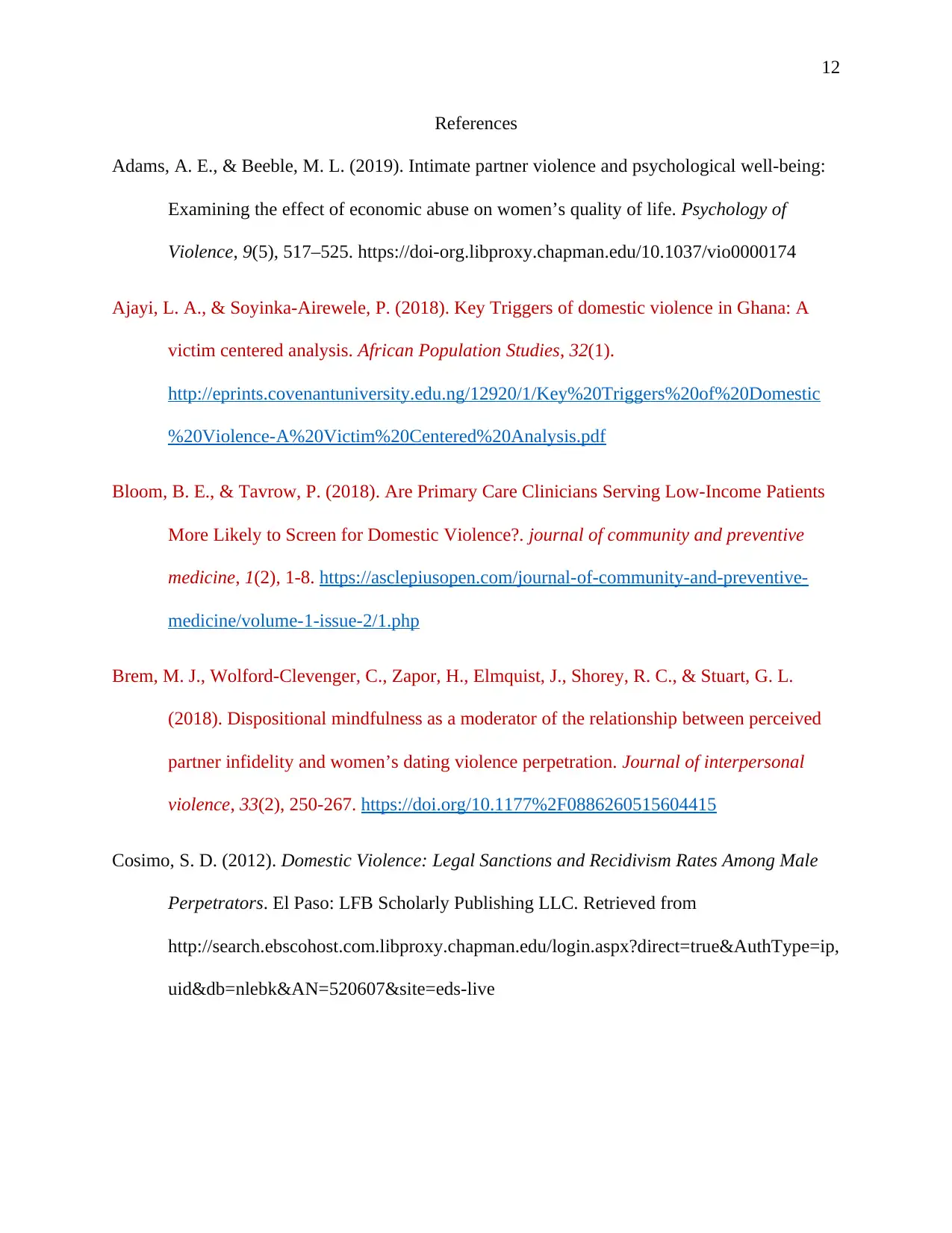
12
References
Adams, A. E., & Beeble, M. L. (2019). Intimate partner violence and psychological well-being:
Examining the effect of economic abuse on women’s quality of life. Psychology of
Violence, 9(5), 517–525. https://doi-org.libproxy.chapman.edu/10.1037/vio0000174
Ajayi, L. A., & Soyinka-Airewele, P. (2018). Key Triggers of domestic violence in Ghana: A
victim centered analysis. African Population Studies, 32(1).
http://eprints.covenantuniversity.edu.ng/12920/1/Key%20Triggers%20of%20Domestic
%20Violence-A%20Victim%20Centered%20Analysis.pdf
Bloom, B. E., & Tavrow, P. (2018). Are Primary Care Clinicians Serving Low-Income Patients
More Likely to Screen for Domestic Violence?. journal of community and preventive
medicine, 1(2), 1-8. https://asclepiusopen.com/journal-of-community-and-preventive-
medicine/volume-1-issue-2/1.php
Brem, M. J., Wolford-Clevenger, C., Zapor, H., Elmquist, J., Shorey, R. C., & Stuart, G. L.
(2018). Dispositional mindfulness as a moderator of the relationship between perceived
partner infidelity and women’s dating violence perpetration. Journal of interpersonal
violence, 33(2), 250-267. https://doi.org/10.1177%2F0886260515604415
Cosimo, S. D. (2012). Domestic Violence: Legal Sanctions and Recidivism Rates Among Male
Perpetrators. El Paso: LFB Scholarly Publishing LLC. Retrieved from
http://search.ebscohost.com.libproxy.chapman.edu/login.aspx?direct=true&AuthType=ip,
uid&db=nlebk&AN=520607&site=eds-live
References
Adams, A. E., & Beeble, M. L. (2019). Intimate partner violence and psychological well-being:
Examining the effect of economic abuse on women’s quality of life. Psychology of
Violence, 9(5), 517–525. https://doi-org.libproxy.chapman.edu/10.1037/vio0000174
Ajayi, L. A., & Soyinka-Airewele, P. (2018). Key Triggers of domestic violence in Ghana: A
victim centered analysis. African Population Studies, 32(1).
http://eprints.covenantuniversity.edu.ng/12920/1/Key%20Triggers%20of%20Domestic
%20Violence-A%20Victim%20Centered%20Analysis.pdf
Bloom, B. E., & Tavrow, P. (2018). Are Primary Care Clinicians Serving Low-Income Patients
More Likely to Screen for Domestic Violence?. journal of community and preventive
medicine, 1(2), 1-8. https://asclepiusopen.com/journal-of-community-and-preventive-
medicine/volume-1-issue-2/1.php
Brem, M. J., Wolford-Clevenger, C., Zapor, H., Elmquist, J., Shorey, R. C., & Stuart, G. L.
(2018). Dispositional mindfulness as a moderator of the relationship between perceived
partner infidelity and women’s dating violence perpetration. Journal of interpersonal
violence, 33(2), 250-267. https://doi.org/10.1177%2F0886260515604415
Cosimo, S. D. (2012). Domestic Violence: Legal Sanctions and Recidivism Rates Among Male
Perpetrators. El Paso: LFB Scholarly Publishing LLC. Retrieved from
http://search.ebscohost.com.libproxy.chapman.edu/login.aspx?direct=true&AuthType=ip,
uid&db=nlebk&AN=520607&site=eds-live
⊘ This is a preview!⊘
Do you want full access?
Subscribe today to unlock all pages.

Trusted by 1+ million students worldwide
1 out of 15
Related Documents
Your All-in-One AI-Powered Toolkit for Academic Success.
+13062052269
info@desklib.com
Available 24*7 on WhatsApp / Email
![[object Object]](/_next/static/media/star-bottom.7253800d.svg)
Unlock your academic potential
Copyright © 2020–2025 A2Z Services. All Rights Reserved. Developed and managed by ZUCOL.




